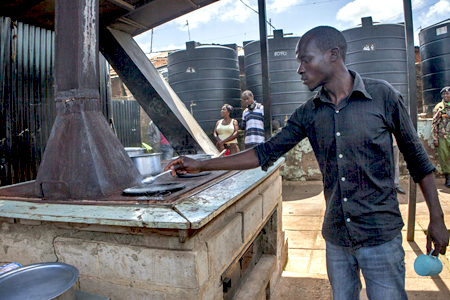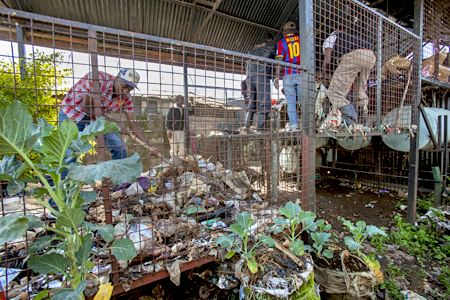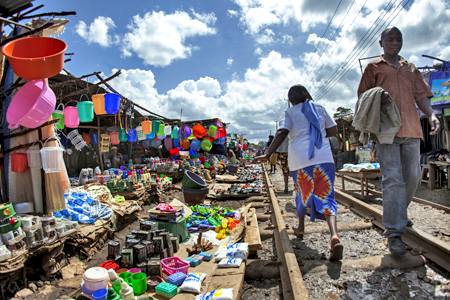The Community Cooker
Hits: 3759Wednesday, 07 October 2009
A remarkable recycling project turns rubbish into energy and potentially transforms slums into resource rich communities
 The disturbing scenes of human deprivation in the highly acclaimed movies Slum Dog Millionaire and The Constant Gardener show the real-life slums in India and Africa overflowing with people and with refuse. But what if the piles of stinking rubbish could be converted into what urban slums need most of all: hot water for washing, pure water for drinking and heat for cooking?
The disturbing scenes of human deprivation in the highly acclaimed movies Slum Dog Millionaire and The Constant Gardener show the real-life slums in India and Africa overflowing with people and with refuse. But what if the piles of stinking rubbish could be converted into what urban slums need most of all: hot water for washing, pure water for drinking and heat for cooking?
Architect, Jim Archer has designed and implemented a 2008 World Architecture Festival (WAF) award-winning project in Kibera, Africa's largest slum, which does just that. The locals in the Laini Saba district have been instrumental to the success of the project they call the "Jiko ya Jamii," that translates from Swahili into the "Community Cooker".
Agnes Aringo is a caterer at Jim's architectural firm in Nairobi. She works on the community cooker and reports that the cooker is versatile and that it boils water, cooks vegetables, stews beef, bakes cakes, fries food, and can be used to prepare breakfast, lunch and dinner, and make cups of tea. The two ovens cook cakes very quickly and each is large enough to grill a whole goat. You can't tell that the fuel used to cook this food is the refuse from the slum. Agnes says, "Nothing is thrown away or should be thrown away in our environment."
A community-led cooker
 The slum dwellers themselves have solved several of the practical problems presented by the cooker project. Volunteers from various local youth groups collect, sort and store the garbage in metal racks adjacent to the cooker where it can dry. Materials that cannot be burnt such as rubber and glass are put to one side.
The slum dwellers themselves have solved several of the practical problems presented by the cooker project. Volunteers from various local youth groups collect, sort and store the garbage in metal racks adjacent to the cooker where it can dry. Materials that cannot be burnt such as rubber and glass are put to one side.
The really useful solid waste materials like paper and plastic - bags, drinks bottles and packaging - as well as food scraps from banana, cassava, maize cob and sugarcane peel, sawdust and even the discarded carrier bags of human and animal excrement colloquially known as ‘flying toilets' are forked up to the top level of the racks ready for incineration. These items would normally be left to rot in the street, thrown into water courses, or dumped in local rivers.
At first, Jim was baffled as how to reward the sorters for their time and effort. "It's very simple," they said. "We will do the sorting for the public from say 6 am until midnight. But from midnight until 6am we will work the cooker for ourselves. We will make bread and we will bake buns and we will heat water. We will sell these and that's how we will make our money." From that moment on, Jim knew they had a working project.
Two taps are the only moving controls on the cooker, which has deliberately been kept very very simple to operate and to maintain. One tap controls a drip flow of recycled sump oil (dirty and discarded oil from vehicles) and one tap controls a drip flow of water. A drop of each falls in equal amounts onto a heated steel plate at the face of the firebox, where the water vaporises into hydrogen and oxygen, which causes a combustive reaction with the flames and increases the temperature. As the firebox gets hotter it heats the network of steel pipes that pass around the cooker. This resourceful technical innovation was the idea of a local man and self-taught furnace-builder Francis Gwehonah, who has helped double the firebox temperature from 300oC to 600oC.
How the community cooker cooks
 The cooker is made entirely of welded steel and has eight circular hotplates on the top. This is similar to a ‘traditional' hob design except that the big metal cooking pots can be partially submerged into the hotplates to gain and retain heat from the firebox below. Hot food is served directly from the saucepans, or can be taken back home by the person who has collected rubbish, or purchased a token to exchange for cooking time. The cooker has two ovens under the hob, one either side of the firebox.
The cooker is made entirely of welded steel and has eight circular hotplates on the top. This is similar to a ‘traditional' hob design except that the big metal cooking pots can be partially submerged into the hotplates to gain and retain heat from the firebox below. Hot food is served directly from the saucepans, or can be taken back home by the person who has collected rubbish, or purchased a token to exchange for cooking time. The cooker has two ovens under the hob, one either side of the firebox.
A tall and narrow chimney rises out of the firebox between the hotplates and reaches high above the slum. White vapour emerges like papal smoke wafting away the almost odourless fumes from the spotlessly clean kitchen area. Sliding down below the hob, a wide metal chute feeds a constant supply of rubbish from the storage racks into the firebox's hungry flames.
Hot water for washing
It costs Sh5 (5 Kenyan shillings, about US$ 0.06) to use the cooker to make a family meal. A local woman Elizabeth Mumbi reckons it's a bargain. She says, "I come here quite often, I find cooking at this communal place quite cost cutting. The Sh5 I pay to use the communal "jiko" is nothing. Imagine how little kerosene or charcoal this money can buy. Nothing costs this little any more."
The cooker heats up water for washing which can be taken to a communal bathroom known as a "bafu". Four large water filled tanks are connected by pipes to each corner of the cooker roof. They act as a reservoir for up to 160 gallons of water at any one time. On average 50 people a day take hot water into the bafu closet, while as many as 200 people could wash from the rain water stored in the tanks.
Since the Laini Saba community cooker became operational in 2007, Jim Archer has drawn up plans to continue to improve the social and environmental conditions in Kibera still further. He wants to increase the number of cookers significantly to one per every 50-70 households, which can contain as many as 20 members per household.
UNEP funds cooker project
 The United Nations Environment Programme (UNEP) is a major supporter of the Community Cooker initiative and has stumped up $10 000 towards its installation. The project is part of the Nairobi River Basin Programme (NRBP), designed to rehabilitate and restore the Nairobi rivers ecosystems to improve livelihoods and enhance biodiversity. UNEP and the Kenyan based Paint Manufacturers BASCO who have also generously contributed to the construction of the prototype are keen to fund more cookers around the slum.
The United Nations Environment Programme (UNEP) is a major supporter of the Community Cooker initiative and has stumped up $10 000 towards its installation. The project is part of the Nairobi River Basin Programme (NRBP), designed to rehabilitate and restore the Nairobi rivers ecosystems to improve livelihoods and enhance biodiversity. UNEP and the Kenyan based Paint Manufacturers BASCO who have also generously contributed to the construction of the prototype are keen to fund more cookers around the slum.
There are seemingly infinite uses to which the basic concept of the community cooker can be applied for local development. These include kilns for clay bricks, pottery and tiles, small hot water systems for homes, hot food and water for hospitals, schools and colleges, hotels and lodges. This relatively low cost and labour engaging project gives people something that they have never had before, hot food and hot water on a regular basis. In addition, it demonstrates that local solutions to specific problems such as the global scourge of plastic and other waste can be transformed into the basic comforts necessary for human wellbeing.
Jim Archer will talk about the Community Cooker in the Jubilee Room at Westminster with former Liberal leader Lord David Steel. This presentation is part of The Green Energies Report, 100% Renewables by 2050 launched on 25th November 2009 in Westminster Green Energies organised by The Institute of Science in Society and hosted by former environment minister Rt Hon Michael Meacher MP.
The full article by Sam Burcher was first published in June 2009 http://www.i-sis.org.uk/theCommunityCooker.php
All photographs are (C) Georgina Goodwin blog.georginagoodwin.com








